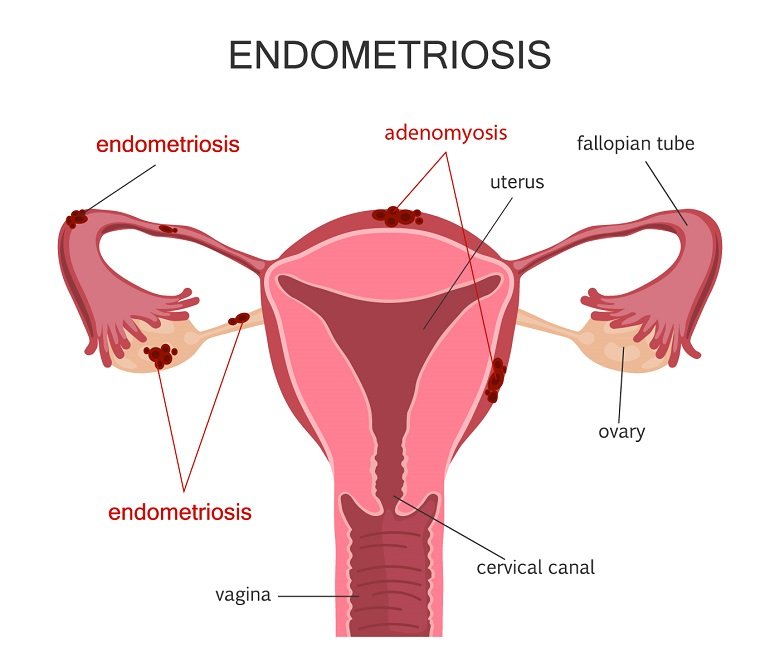
Endometriosis Surgery: Laparoscopy, Recovery, and More
Endometriosis is a painful condition that can affect a woman’s daily life because the tissue similar to the lining of the uterus grows in other places outside the uterus, like within the abdomen and pelvic area. The growth of these tissues in the wrong places can lead to pain, especially during menstrual periods, discomfort during intercourse, and fertility problems.
Endometriosis Surgery: Causes and Symptoms
The endometrium is the inner lining of the uterus, mostly made up of mucosal tissue. It’s the tissue that you shed during the menstrual period.
A person dealing with endometriosis experiences symptoms such as abdominal pain, pain during intercourse, difficulty getting pregnant, and heavy bleeding between periods.

The severity of the pain experienced in endometriosis usually varies from person to person. It usually depends on the severity of the condition and the location of the endometrial tissue growth. Some may have mild discomfort, while others may have intense pain that disrupts their daily activities.
The exact cause of endometriosis is not known; however, several other factors can lead to endometriosis, such as immune system disorders, genetic factors, hormonal imbalances, and environmental factors.
Laparoscopic Surgery for Endometriosis
Treatment of endometriosis usually depends on the severity of the individual condition. The main aim of the surgery is to remove the endometriosis through different approaches. One of the best methods for removing endometriosis is laparoscopy.
Laparoscopy Endometriosis Surgery

Laparoscopy is a type of keyhole surgical procedure that is used to diagnose and treat conditions, including endometriosis.
In this surgery, the gynaecologist inserts the medical thin tube-like instrument with a light and camera at one end by making a small incision across the abdomen. It is a minimally invasive approach in which a laparoscope is used to have a magnified view of the pelvic cavity so that the doctor can easily locate and assess the extent of the condition and remove it with surgical instruments.
How To Prepare for the Laparoscopy Procedure?
Before the procedure, there are several things your doctor may ask you to do, and here are some of them.
- Consultation

You can consult your gynaecologist before the procedure to discuss the concerns, benefits, and risks associated with the laparoscopy procedure.
- Medical Evaluation
The doctor will evaluate your medical condition with some tests, such as blood tests and imaging scans, to assess your overall health. It is also done to assure you that you are medically fit for the surgical procedure.
- Medications
You may be asked to stop or adjust certain medications before the procedure; therefore, it is essential to inform your doctor about any medicines you take.
- Endometriosis
Your doctor will advise you not to eat or drink for a certain period, usually the night before the procedure.
How Is Laparoscopy Performed?

Laparoscopy surgery is performed under general anaesthesia to prevent pain and discomfort during the surgery. After the sedation, the doctor will make a minor incision around the navel to insert the laparoscope and surgical instrument to take out the sample and remove the scar tissue if found. It is an outpatient surgery performed at the gynaecologist’s clinic or hospital. After the laparoscopy procedure, you will be sent to recovery.
Recovery After Laparoscopy
Every individual recovers differently from a surgical procedure. Laparoscopy is a minimally invasive procedure with fewer risks in comparison to traditional procedures.
When it comes to recovery, you will be advised to do the following things to achieve a speedy recovery from the surgery:
- Prioritise rest and allow your body to heal
- Eat a healthy and well-balanced diet
- Follow your doctor’s instructions
- Take medications as prescribed by your medical professional
- Avoid lifting heavy objects for a specific period
- Gradually increase your activity level
- Do not miss follow-up appointments with your doctor
CONCLUSION
Are you experiencing symptoms such as pelvic pain, pain during periods, and difficulty getting pregnant? You might be dealing with endometriosis. These symptoms can affect your daily routine; therefore, it is essential to consult your gynaecologist for an accurate diagnosis and treatment.